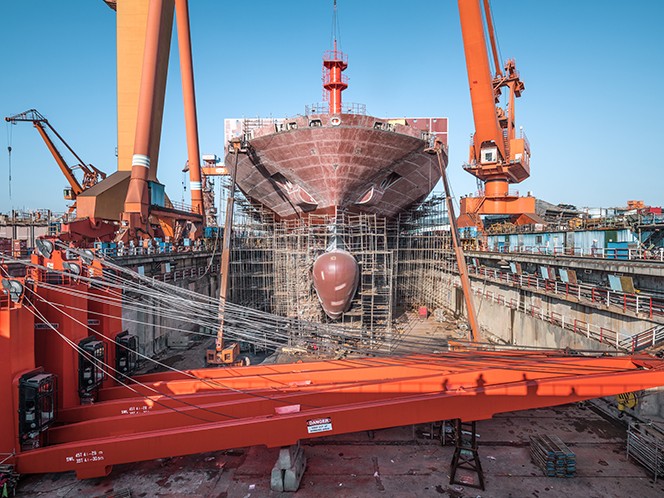Digital shipbuilding: Cutting costs and lead times
Posted: Oct 01, 2025

In the budget breakdown of a new ship build, around 5% of project spending goes to engineering; 25–35% goes to direct and indirect labor. The majority of the budget—some 60–70%—owes directly to material costs.
The key, then, to controlling project cost isn’t just in the efficiency of your workforce or your engineering. It’s in mastering material flow from end to end.
Of course, that’s easier said than done. In traditional shipyards, material flow is fragmented by siloed departments and disconnected systems, and it’s managed with limited visibility and manual handovers. In this fractured project landscape, teams inevitably struggle to keep complex projects aligned. The result is a cascade of familiar challenges:
- Siloed departments, systems, and information
Without integration between departments, teams must re-enter the same data into multiple systems, leading to unreliable or conflicting information, wasted time spent tracking down data, and breakdowns in cross-discipline planning. It also makes it laborious or impossible to extract accurate managerial KPIs for fast, informed decision-making.
- Inefficient material management
Given how much budget goes to materials, poor material management—such as overspending in acquisition, double ordering, overstocking, or missing parts—can quickly snowball into major cost overruns
- Lack of control and visibility
When teams operate in the dark, they risk working from outdated designs or incomplete bills of materials (BOMs), which can lead to mismatched kits, invalid documentation, installation errors, and costly rework and delays.
Solving these challenges requires more than software upgrades or point solutions. The shipbuilding industry needs an integrated approach that unites engineering, procurement, planning, and construction teams in a common data environment with full visibility into what’s needed, when, and why.
Real-world success: Oceana streamlines the shipbuilding process
Founded in 2013, Brazil-based shipyard Oceana is the relative new kid on the block. To convince customers to jump ship, Oceana couldn’t just do as well as its more seasoned competitors; it had to do even better. That’s why it united its departments and harmonized work across the project lifecycle with AVEVA™ Enterprise Resource Management.
Let’s revisit those challenges we looked at back at the top of the page and see how Oceana’s integrated approach to the shipbuilding process makes all the difference.
Siloed departments
With AVEVA Enterprise Management, and a shared data environment, Oceana integrated supply chain functions—like procurement, warehousing, and planning—with engineering and construction workflows. This enables the shipbuilder’s teams to work together in lockstep. Regardless of their department, everybody shares the same view of the same information, which enhances collaboration between disciplines and supply chain partners.
Now, information is entered into just the one system, just the one time, and as designs change, the project roadmap always remains up to date. And, with one central hub of reliable information, leadership can easily access the big-picture KPIs they need to understand performance and make faster, better-informed decisions.
Inefficient material management
By connecting engineering outputs directly to procurement and warehouse systems, Oceana’s new, integrated environment enables teams to forecast material needs more accurately, avoid double ordering, and ensure materials are available exactly when needed without overstocking.
The dedicated material management tool included in AVEVA Enterprise Resource Management supports the flow of materials from budgeting through requirements, procurement, receipt, warehousing, and issue.
Lack of control and visibility
Through integrated planning and real-time visibility into design changes, Oceana ensures that construction crews work from up-to-date designs and accurate BOMs, which reduces the risk of installing incorrect components and cuts down on errors and rework.
With greater visibility across the project lifecycle, Oceana can now release work orders closer to the execution date, avoiding early-stage inaccuracies, maximizing agility, and empowering the shipyard with the flexibility it needs to navigate disruptions or delays, enhance accuracy and coordination, and streamline production flow.
Oceana also uses its new system to track workhours against specific work orders in real time. That allows planners to see how work is progressing, whether crews are on schedule, and where adjustments are needed. Combined with reliable, up-to-date designs and BOMs, this visibility helps prevent rework and avoid costly surprises down the line.
Industry-leading outcomes
With its new, digitally integrated approach powered by AVEVA solutions, Oceana is delivering new builds on schedule, or even ahead of schedule, saving costs, and impressing customers. In fact, an independent study of the shipbuilding market found that Oceana now leads the industry in production times, an achievement the company credits, in no small part, to this approach and the AVEVA solutions that enabled it.
Oceana’s success illustrates an essential lesson for the industry, and for capital projects more broadly: Integration is about more than just the newest technology. It’s about collaboration, visibility, and making shared data work toward shared goals.
Related blog posts
Stay in the know: Keep up to date on the latest happenings around the industry.